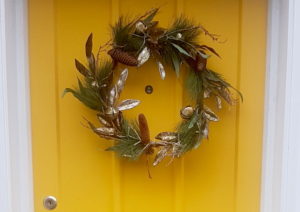The tradition of Christmas door wreaths

Drive down any street in December and there is one feature that can be seen on houses of all sizes – a colourful wreath on the door. Traditionally, these are made of holly, although now it might be anything from berries to plastic baubles. But why is this used as a symbol of Christmas?
Wreaths have a long history and can be found in the traditions of many countries. A wreath of laurel or olive branches was used in Greek times as a sporting trophy and is still used as a motif on some Olympic medals. Meanwhile, the Romans (who invaded Britain in 43CE) had a tradition of hanging wreaths on their door as a sign of victory and the custom may originally have come from them.
The word wreath means ‘twisted’ in Old English, a language used from about the year 440, so it suggests they have a long history in this country. From medieval times, churches at Christmas were decorated with holly and ivy. The holly with its spiky leaves and red berries symbolised Jesus Christ’s crown of thorns and blood from the time he was killed on the cross. The ivy symbolised his mother Mary. It is likely these beliefs were converted from earlier pagan symbolism – it is no surprise that evergreen plants are special during winter when most other plants seem dead. The circle shape of the wreath represents everlasting life, which has also made wreaths popular at funerals and memorials. Sometimes people use door wreaths at Easter, decorated with eggs and flowers.
So while we can’t know for sure, it seems likely that influences from Romans, pagans and Christians have all played their part in creating our tradition of decorating doors with Christmas wreaths. But whatever their original meaning, perhaps the greatest symbolism now is of something else: a warm welcome on a cold, grey winter day.



